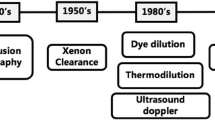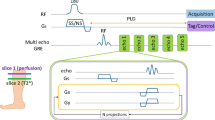Abstract
Purpose
The purpose of this study was to evaluate the change in capillary blood volume in the muscles of the lower limbs, before and after exercise, using intravoxel incoherent motion (IVIM).
Materials and methods
Diffusion-weighted images were obtained (with 16 b values) from the thigh and leg muscles of 11 subjects. The imaging was obtained before and immediately exercise; additionally, imaging was performed at 3 h, 6 h, and 24 h after exercise, and an IVIM index was calculated. The exercise involved walking up and down a flight of stairs (140 steps) ten times. The IVIM of each time course—before and after the exercise—was compared. In addition, we examined the correlation of IVIM measurements with the degree of the muscle ache that occurred at 24 h following the exercise.
Results
The IVIM index significantly increased after exercise compared with that before exercise (P < 0.01). IVIM decreased at 3 h following exercise, but increased again at 24 h. A correlation was found between the IVIM index at 24 h after exercise and the degree of the muscle ache (r = 0.80)
Conclusions
The capillary blood volume significantly increased after exercise when compared to before exercise. The capillary blood volume decreased after exercise at 3 h and 6 h following exercise, but it increased again at 24 h. There was a correlation between the degree of muscle ache and the amount of capillary blood volume measured from the femoral muscle at 24 h after exercise.






Similar content being viewed by others
References
Ogura A, Hayakawa K, Miyati T, Maeda F (2011) Imaging parameter effects apparent diffusion coefficient determination of magnetic resonance imaging. Eur J Radiol 77:185–188. https://doi.org/10.1016/j.ejrad.2009.06.031
Schwarcz A, Bogner P, Meric P, Correze JL, Berente Z, Pál J et al (2004) The existence of biexponential signal decay in magnetic resonance diffusion-weighted imaging appears to be independent of compartmentalization. Magn Reson Med 51:278–285. https://doi.org/10.1002/mrm.10702
Niendorf T, Dijkhuizen RM, Norris DG, van Lookeren CM, Nicolay K (1996) Biexponential diffusion attenuation in various states of brain tissues: implications for diffusion-weighted imaging. Magn Reson Med 36:847–857. https://doi.org/10.1002/mrm.1910360607
Chin CL, Wehrli FW, Hwang SN, Takahashi M, Hackney DB (2002) Biexponential diffusion attenuation in the rat spinal cord: computer simulations based on anatomic images of axonal architecture. Magn Reson Med 47:455–460. https://doi.org/10.1002/mrm.10078
Hall MG, Bongers A, Sved P, Watson G, Bourne RM (2015) Assessment of non-Gaussian diffusion with singly and doubly stretched biexponential models of diffusion-weighted MRI (DWI) signal attenuation in prostate tissue. NMR Biomed 28:486–495. https://doi.org/10.1002/nbm.3273
Le Bihan D, Breton E, Lallemand D, Aubin ML, Vignaud J, Laval-Jeantet M (1988) Separation of diffusion and perfusion in intravoxel incoherent motion MR imaging. Radiology 168:497–505. https://doi.org/10.1148/radiology.168.2.3393671
Iima M, Le Bihan D (2016) Clinical intravoxel incoherent motion and diffusion MR imaging: past, present, and future. Radiology 278:13–32. https://doi.org/10.1148/radiol.2015150244
Pang Y, Turkbey B, Bernardo M, Kruecker J, Kadoury S, Merino MJ et al (2013) Intravoxel incoherent motion MR imaging for prostate cancer: an evaluation of perfusion fraction and diffusion coefficient derived from different b-value combinations. Magn Reson Med 69:553–562. https://doi.org/10.1002/mrm.24277
Shinmoto H, Tamura C, Soga S, Shiomi E, Yoshihara N, Kaji T et al (2012) An intravoxel incoherent motion diffusion-weighted imaging study of prostate cancer. AJR Am J Roentgenol 199:496–500. https://doi.org/10.2214/AJR.11.8347
Luciani A, Vignaud A, Cavet M, Nhieu JT, Mallat A, Ruel A et al (2008) Liver cirrhosis: intravoxel incoherent motion imaging—pilot study. Radiology 249:891–899. https://doi.org/10.1148/radiol.2493080080
Lewin M, Fartoux L, Vignaud A, Arrive L, Menu Y, Rosmorduc O (2011) The diffusion-weighted imaging perfusion fraction f is potential marker of sorafenib treatment in advanced hepatocellular carcinoma: a pilot study. Eur Radiol 21:281–290. https://doi.org/10.1007/s00330-010-1914-4
Federau C, Meuli R, O’Brien P, Maeder P (2014) Hahmann P (2014) Perfusion measurement in brain gliomas with intravoxel incoherent motion MRI. AJNR Am J Neuroradiol 35:256–262. https://doi.org/10.3174/ajnr.A3686
Liu C, Liang C, Liu Z, Zhang S, Huang B (2013) Intravoxel incoherent motion (IVIM) in evaluation of breast lesions: comparison with conventional DWI. Eur J Radiol 82:e782–e789. https://doi.org/10.1016/j.ejrad.2013.08.006
Lee EYP, Hui ESK, Chan KKL, Tse KY, Kwong WK, Chang TY et al (2015) Relationship between intravoxel incoherent motion diffusion-weighted MRI and dynamic contrast-enhanced MRI in tissue perfusion of cervical cancers. J Magn Reson Imaging 42:454–459. https://doi.org/10.1002/jmri.24808
Klauss M, Lemke A, Grunberg K, Simon D, Re TJ, Wente MN et al (2011) Intravoxel incoherent motion MRI for the differentiation between mass forming chronic pancreatitis and pancreatic carcinoma. Investig Radiol 46:57–63. https://doi.org/10.1097/RLI.0b013e3181fb3bf2
Klaub M, Maier-Hein K, Tjaden C, Thackert T, Grenacher L, Stieltjes B (2016) IVIM DW-MRI of autoimmune pancreatitis: therapy monitoring and differentiation from pancreatic cancer. Eur Radiol 26:2099–2016. https://doi.org/10.1007/s00330-015-4041-4
Nougaret S, Vargas HA, Lakhman Y, Sudre R, Do RKG, Bibeau F et al (2016) Intravoxel incoherent motion derived histogram metrics for assessment of response after combined chemotherapy and radiation therapy in rectal cancer: Initial experience and comparison between single-section and volumetric analyses. Radiology 280:446–454. https://doi.org/10.1148/radiol.2016150702
Srinivasan VJ, Radhankrishan H, Lo EH, Mandeville ET, Jiang JY, Barry S et al (2012) OCT methods for capillary velocimetry. Biomed Opt Express 3:612–629. https://doi.org/10.1364/BOE.3.000612
Baran U, Shi L, Wang RK (2015) Capillary blood flow imaging within human finger using optical microangiography. J Biophotonics 8:46–51. https://doi.org/10.1002/jbio.201300154
Styf JR, Crenshaw A, Hargens AR (1989) Intramuscular pressures during exercise comparison of measurements with and without infusion. Acta Orthop Scand 60:593–596. https://doi.org/10.3109/17453678909150129
Selkow NM, Herman DC, Liu Z, Hertel J, Hart JM, Saliba SA (2015) Blood flow after exercise-induced muscle damage. J Athl Train 50:400–406. https://doi.org/10.4085/1062-6050-49.6.01
Mense S (2008) Muscle pain: mechanisms and clinical significance. Dtsch Arzlebl Int 105:214–219. https://doi.org/10.3238/artzebl.2008.0214
Ogura A, Hayakawa K, Maeda F (2016) Novel evaluation of intravoxel incoherent motion using Fourier analysis for prostate cancer detection. J Diagn Tech Biomed Anal 5:1–5. https://doi.org/10.1594/ecr2015/C-0023
Poole DC, Copp SW, Ferguson SK, Musch TI (2013) Skeletal muscle capillary function: contemporary observations and novel hypotheses. Exp Physiol 98:1645–1658. https://doi.org/10.1113/expphysiol.2013.073874
Bouwsema MM, Tedjasaputra V, Stickland MK (2017) Are there sex differences in the capillary blood volume and diffusing capacity response to exercise? J Appl Physiol 122:460–469. https://doi.org/10.1152/japplphysiol.00389.2016
Hidebrandt W, Schwarzbach H, Pardun A, Hannemann L, Bogs B, König AM et al (2017) Age-related differences in skeletal muscle microvascular response to exercise as detected by contrast-enhanced ultrasound (CEUS). PLoS ONE 12:e0172771. https://doi.org/10.1371/journal.pone.0172771
Tediasaputra V, Bouwsema MM, Sticklang MK (2016) Effect of aerobic fitness on capillary blood volume and diffusing membrane capacity responses to exercise. J Physiol 594:4359–4370. https://doi.org/10.1113/JP272037
Armstrong RB (1984) Mechanisms of exercise-induced delayed onset muscular soreness: a brief review. Med Sci Sports Exerc 16:529–538
Funding
The authors state that this work has not received any funding.
Author information
Authors and Affiliations
Corresponding author
Ethics declarations
Conflict of interest
The all authors of this manuscript declare no relationships with any companies, whose products or services may be related to the subject matter of the article.
Ethical approval
All procedures performed in studies involving human participants were in accordance with the ethical standards of the institutional and/or national research committee and with the 1964 Helsinki declaration and its later amendments or comparable ethical standards.
Guarantor
The scientific guarantor of this publication is Dr. Kuniaki Takada.
Informed consent:
All study participants provided informed consent, and the study design was approved by the appropriate ethics review board.
Statistics and biometry
No complex statistical methods were necessary for this paper.
Study subjects or cohorts overlap
None.
Additional information
Publisher's Note
Springer Nature remains neutral with regard to jurisdictional claims in published maps and institutional affiliations.
Rights and permissions
About this article
Cite this article
Ogura, A., Sotome, H., Asai, A. et al. Evaluation of capillary blood volume in the lower limb muscles after exercise by intravoxel incoherent motion. Radiol med 125, 474–480 (2020). https://doi.org/10.1007/s11547-020-01163-5
Received:
Accepted:
Published:
Issue Date:
DOI: https://doi.org/10.1007/s11547-020-01163-5




